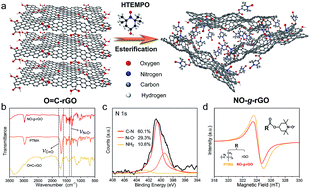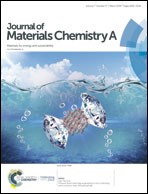Polynitroxide-grafted-graphene: a superior cathode for lithium ion batteries with enhanced charge hopping transportation†
Abstract
The emergence of organic nitrogen-oxide (NO) radical polymers has brought hope in the pursuit of high performance lithium-ion batteries (LIBs). However, the unstable conductivity has always caused the NO polymer electrodes to have inferior electrochemical performance. Herein, we constructed a new and remarkably conductive polynitroxide-grafted-graphene (NO-g-rGO) cathode that is similar to organic polymer cathodes with a high concentration of nitroxide radicals. Elevated levels of NO on the surface of reduced graphene oxide (rGO) were achieved via esterification between 4-hydroxy-2,2,6,6-tetramethylpiperidine-1-oxyl (HTEMPO) and a high concentration of carboxylated rGO. The fold on the surface of rGO shortens the distance of electron transport between radical monomers, thereby enhancing the conductivity of NO-g-rGO, which showed a high specific capacity of 256 mA h g−1 after 200 cycles. The dramatic performance of NO-g-rGO was achieved through promoting the conductivity of NO. As a novel concept, this work provides a fresh perspective on the application of organic radical cathodes in high energy density LIBs.



 Please wait while we load your content...
Please wait while we load your content...